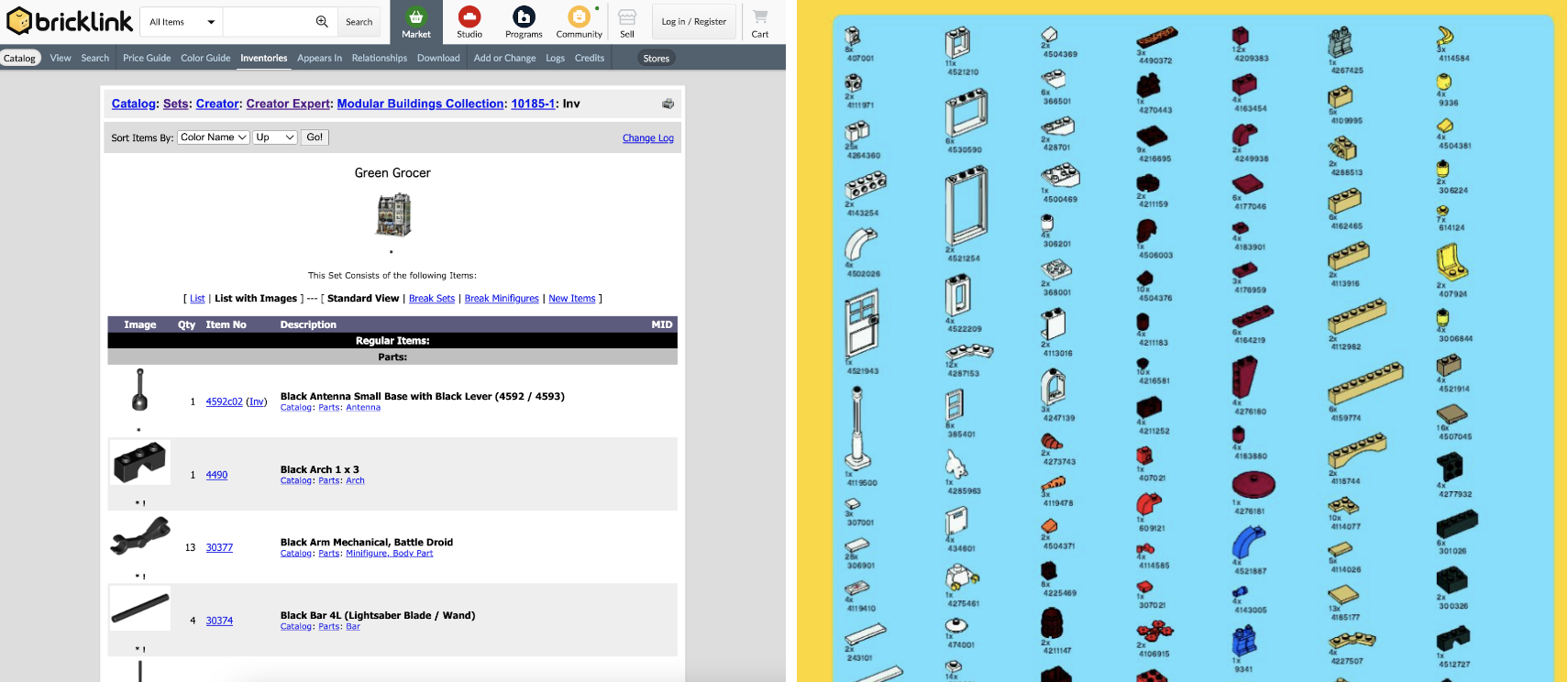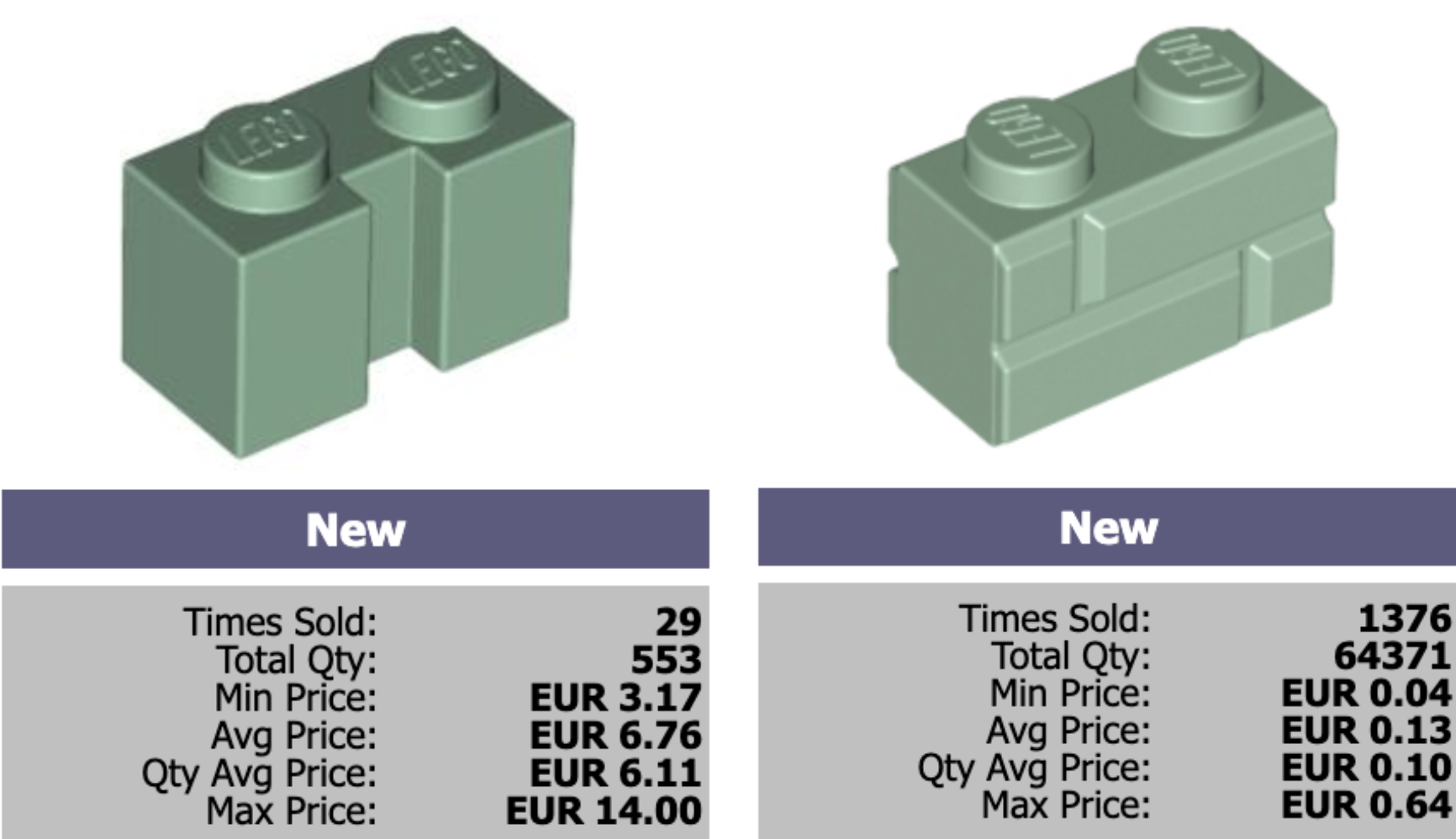After analysing 6049 sets from Brickset, it was possible to conclude that on average a LEGO set is available for sale during 18 months. Of course there are exceptions, such as the 10220 Volkswagen T1 Camper Van as one of the sets being sold for longer around 9 years, and the 41624: Mickey Mouse one of the sets for sale for the least time with only 4 months.

Once a LEGO set stops being sold, only second hand and private sellers remain. As their availability becomes smaller, prices tend to skyrocket (find more on brickeconomy.com). As an example, the 10185 Green Grocer was launched with a retail price of €150 in 2008. Fast-forward 15 years, and the cost (new) is currently €1600, a growth over 970% (with an annual growth around 17%).

As much as I would like to complete my modular buildings’ collection, this price is not reasonable for me, and with that value I am able to afford other interesting LEGO sets in the market. However, I really wanted to have that building (as much as possible) in my collection.
An obvious alternative was looking into the second hand market, however things aren’t much better there, with prices varying from around €800 to €1000 – far from a reasonable value for me. Thus, I was left with the third and cheapest option, which was to replicate the sets as close as possible, but with modern pieces (also known as “rebrick”). In this article, I would like to tell you my experience rebuilding the 10185: Green Grocer set, which is now part of my collection.
So, what exactly is “rebrick”? In theory, it is very simple: you select an existing LEGO set, as built by LEGO, gather the pieces used to build that set in the first place, and build it by yourself following the existing instructions. Easy, right? Well, in practice things aren’t usually as simple as in theory, and this is no exception. Let’s go step by step to better explain my perspective, and I will use the 10185 Green grocer as an example, since it was one of the sets I’ve built this way.
The process of rebrick
The first step to rebuild a LEGO set is to figure out the required parts. While LEGO instructions booklets include the list of parts at the end, a more efficient way is to resort to Bricklink, as not only the information is more complete (number, variations, updated components, etc), but it also allows for easier management of parts, for instance through wanted lists, which can be generated from the parts of a set – very helpful! This was the method I used to build my set.

Bricklink also offers the option to buy all parts from a list. However, doing so would result in a cost higher than a new copy of the set. This is due to the fact that some parts have been long discontinued, and their prices have skyrocketed. An example is the sand green modified brick, with prices of a single part averaging €6. This was the first roadblock in the process – figure out the parts whose price is excessive.

Luckily, Bricklink also helps in the case of parts which have been discontinued, but have a direct replacement, often with minimal changes, such as the 3957 Antenna vs 3957b Antenna (round vs flat top). For the remaining cases, I had to choose either to go for a different part, or different colour, and I’ve opted for the latter one (98283 modified brick with masonry pattern).
This allowed for a price around 45 times lower than the original brick. The last step is to buy the parts themselves. Without going into further detail, it’s a matter of deciding on the status (new vs used), bigger vs smaller orders, and source (e.g. Bricklink vs LEGO).
Once all parts are gathered, it’s time to assemble the set. Since LEGO provides official build instructions, it’s just a matter of getting the right file. The only noteworthy difference regards parts organization. While there are different approaches, I’ve organized them by colour, which work pretty well for me.

Opinion on the process
Looking back, recreating an old LEGO set, it’s not without its issues. First of all, and starting with the advantages, the most obvious one is the possibility to have a set which resembles the original discontinued one, but with a substantially lower cost. Indeed, the overall price I paid for the parts was around €200~€250, which is the price of a new modular building, with a similar part count (for instance, the 10270 Bookshop).
The price might be lower if you are able to find better deals, wait for prices to lower, find cheaper parts, make more compromises (e.g. use cheaper colours) or use used parts, which make it even a better deal. Another advantage is the capability to buy the parts at your own pace.
This means you can, for instance, wait for better deals when buying, wait for restocks (e.g. from LEGO), or simply buy everything at once. Finally, making a set on my own, I had the capability to tweak it as much as I wanted, and use modern parts as much as I desired.

Of course, there are also disadvantages. First of all, the resulting set is not the original one, so picky collectors won’t be satisfied by the result, so it most probably isn’t even worth it for them. The process itself is quite laborious, from finding the parts, taking track of them, making different orders, checking your parts against the required ones, and dealing with mistakes (e.g. wrong parts or quantities ordered).
Regarding the parts, some older ones become more fragile as time passes, so some might crack or break during assembly (happened to me). Finally, the retail value will always be close to the cost of the parts, opposed to official LEGO sets which tend to go up in value.
For me, the overall balance is positive: I now have in my collection a set which is similar enough to the original, and creates the visual impact I was looking for, without having to pay the premium price the original set costs. My advice for collectors thinking about doing this is to carefully analyse the sets to build, price of parts, impact of the parts to be replaced (both in price and in the set itself), and balance all of that with the difference in cost. In the end, for me, this was a task of dedication and willingness to complete my collection, despite the compromises.
What comes next?

Personally, rebuilding an older set with new parts is almost a work of love, dedication, research and compromise, almost like a hobby within a hobby, constantly looking for parts and assembling them a few at the time, until finally building the set.
Given the results of rebuilding the Green Grocer, once I finished it I started gathering the parts for the 10182 Cafe corner, where I will be applying the same process as before.
Finally, it is worth noting that not all the LEGO sets are equally laborious and expensive to build. Two other kinds of sets I’ve rebuilt were limited run ones (GWP and Brickheadz).
In that case, they were fairly easier and cheaper to build, but often required to forgo some parts (e.g. exclusive printing) – a small compromise I was willing to do.
Leave a Reply
You must be logged in to post a comment.